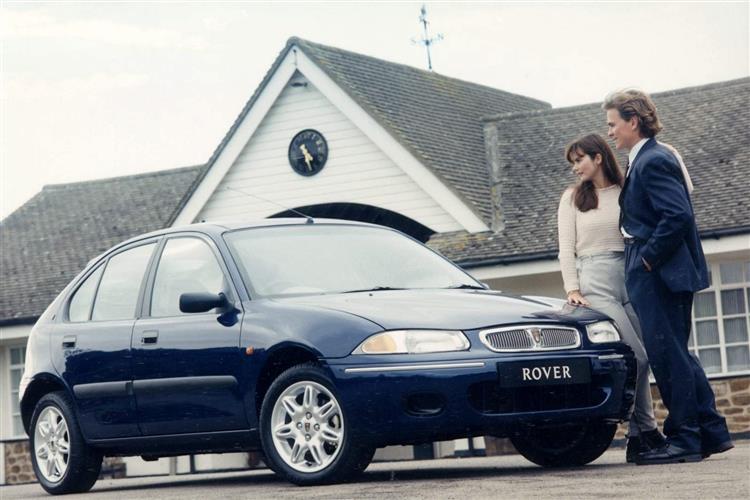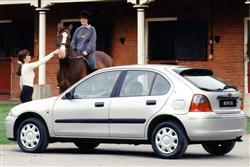SMOOTH OPERATORS (some text hidden) --NONE--
BY JONATHAN CROUCH
Introductionword count: 167
This was the car that should originally have replaced the Metro from the very start, before Rover had a re-think, deciding instead that it should move its range upmarket, starting with something sized halfway between a Fiesta and an Escort. Mechanically similar to the previous second-generation 200, and sharing some inner body panels, this replacement model was a smoothly styled hatchback, pitched more as a compact executive car than a superior supermini. The 200 was a great success for Rover, lifting its maker's image and returning it to the top-10 best sellers lists, after the gradual decline of the Metro, or 100, as it was renamed. The main criticism of the 200 was always a somewhat cosy rear compartment. Rover felt that what was now their smallest model should be thought of more as a personal coupe (even the five-door versions?) than a compact family car, so if rear leg room matters less than a classy cabin and elegant styling, the 200 could well be for you.
Modelsword count: 67
Models Covered: THIRD GENERATION 200 - NOVEMBER 1995-1999: 1.1i three & five-door [211i, 200SE, 200iE] / 1.4i three & five-door [214, 214SE, 214S, 214i, 214Si, 214iS, 214iE, 214iL] / 1.6i three & five-door [216iE, 216Si, 216iS, 216iL, 216SLi, 216GSi] / 1.8i three & five-door [218iS, 200vi] / 2.0 diesel three & five-door [220SE, 220iE, 220iS, 220iL, 220DS turbo, 220D turbo, 220 SD turbo, 220Di turbo, 220SDi turbo]
Historyword count: 323
Launched at the Earl's Court Motor Show in late 1995, the 200 appeared to a somewhat surprised public. Its lines were much admired and the promise of a three-door vi version, equipped with the MGF's 1.8-litre VVC engine, ensured an enthusiastic, if cautious welcome from the motoring press. The rest of the engine line-up was familiar, having been carried over from the old-shape 200, though the Peugeot diesels were replaced by Rover's own 2.0-litre units. Both three and five-door variants were immediately available, in a wide variety of trim levels, all of them with an emphasis on luxury features. Apart from the introduction of price-leading models and a slight re-ordering of model names in the summer of 1997, the range remained unchanged, apart from the introduction of two 1.8-litre versions. Confusingly, though, all models were now badged just '200', regardless of derivative (which doesn't much help when you're scouring a dealer's display in search of a particular version). Available as both a three and five-door, the 218iS appeared in late summer 1997, following hot on the heels of a five-door vi. The original three-door vi, shown at the time of the original launch, had itself only become available in January 1997, due to 'production difficulties'. The sell-out success of the MGF had caught Rover by surprise, with the result that every engine that could be produced was earmarked for the roadster - its hatchback cousins had to wait. Later that year, an entry-level 1.1-litre version - the 211i - was launched to replace the discontinued 100. In June 1999, the line-up received its last range of revisions in 200 form, with the trim levels changed to include SE, iE, iL and iS, the latter two having been offered as special editions for the previous two months. The 200 was replaced by the 25 in November 1999. The new car has a distinctive four-headlight nose and numerous detail styling, trim, equipment and mechanical changes.
What You Getword count: 116
Rover's stylists did a remarkable job of updating what is, after all, a new body on existing, if modernised mechanicals and platform components. Both three and five-door versions combine the traditional Rover grille and touches of chrome with up to the minute styling and a purposeful stance. Inside, there's a familiar Rover feel to the cabin, with high quality trim and switchgear as well as wood inserts in a fascia which accommodates driver and passenger airbags, depending on the trim level of the version you're considering. The front seats have very long-travel runners to boost front cabin space, since the marketing men always felt that most potential owners would use the back only for young children.
To see the full road test text contact us on 0330 0020 227
Pictures (high res disabled)


|
Scoring (subset of scores)
Category: Small Runabouts
| Performance | |
| Handling | |
| Comfort | |
| Space | |
| Styling, Build, Value, Equipment, Depreciation, Handling, Insurance and Total scores are available with our full data feed. | |



